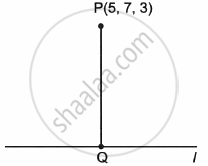Advertisements
Advertisements
प्रश्न
Find the coordinates of the foot of the perpendicular drawn from point (5, 7, 3) to the line `(x - 15)/3 = (y - 29)/8 = (z - 5)/-5`.
उत्तर
Given point is P(5, 7, 3) and line is
`(x - 15)/3 = (y - 29)/8 = (z - 5)/-5` = k
Let any point Q on this line with coordinates (3k + 15, 8k + 29, – 5k + 5).

Now direction ratio of line PQ is
(3k + 15 – 5), (8k + 29 – 7), (– 5k + 5 – 3)
= 3k + 10, 8k + 22, – 5k + 2
and direction ratio of given line l are (3, 8, – 5)
∵ PQ ⊥ l
∴ 3(3k + 10) + 8(8k + 22) – 5(– 5k + 2) = 0
9k + 30 + 64k + 176 + 25k – 10 = 0
98k + 196 = 0
k = `(-196)/98` = – 2
Hence foot of perpendicular drawn on the given line is [3 × (– 2) + 15, 8 × (– 2) + 29, – 5 × (– 2) + 5] = (9, 13, 15).
APPEARS IN
संबंधित प्रश्न
If l, m, n are the direction cosines of a line, then prove that l2 + m2 + n2 = 1. Hence find the
direction angle of the line with the X axis which makes direction angles of 135° and 45° with Y and Z axes respectively.
If a line makes angles of 90°, 60° and 30° with the positive direction of x, y, and z-axis respectively, find its direction cosines
If a line has direction ratios 2, −1, −2, determine its direction cosines.
Find the direction cosines of the line passing through two points (−2, 4, −5) and (1, 2, 3) .
Find the angle between the vectors whose direction cosines are proportional to 2, 3, −6 and 3, −4, 5.
Find the acute angle between the lines whose direction ratios are proportional to 2 : 3 : 6 and 1 : 2 : 2.
Show that the line through the points (1, −1, 2) and (3, 4, −2) is perpendicular to the line through the points (0, 3, 2) and (3, 5, 6).
Find the angle between the lines whose direction cosines are given by the equations
2l − m + 2n = 0 and mn + nl + lm = 0
What are the direction cosines of Y-axis?
Write the distance of the point (3, −5, 12) from X-axis?
Write direction cosines of a line parallel to z-axis.
For every point P (x, y, z) on the x-axis (except the origin),
The xy-plane divides the line joining the points (−1, 3, 4) and (2, −5, 6)
The distance of the point P (a, b, c) from the x-axis is
If O is the origin, OP = 3 with direction ratios proportional to −1, 2, −2 then the coordinates of P are
If a line makes angles 90°, 135°, 45° with the x, y and z axes respectively, find its direction cosines.
Verify whether the following ratios are direction cosines of some vector or not
`1/sqrt(2), 1/2, 1/2`
Verify whether the following ratios are direction cosines of some vector or not
`4/3, 0, 3/4`
Find the direction cosines of a vector whose direction ratios are
1, 2, 3
Find the direction cosines of a vector whose direction ratios are
0, 0, 7
Find the direction cosines and direction ratios for the following vector
`hat"i" - hat"k"`
Find the direction cosines of the line passing through the points P(2, 3, 5) and Q(–1, 2, 4).
The x-coordinate of a point on the line joining the points Q(2, 2, 1) and R(5, 1, –2) is 4. Find its z-coordinate.
If α, β, γ are the angles that a line makes with the positive direction of x, y, z axis, respectively, then the direction cosines of the line are ______.
Find the equations of the two lines through the origin which intersect the line `(x - 3)/2 = (y - 3)/1 = z/1` at angles of `pi/3` each.
The line `vec"r" = 2hat"i" - 3hat"j" - hat"k" + lambda(hat"i" - hat"j" + 2hat"k")` lies in the plane `vec"r".(3hat"i" + hat"j" - hat"k") + 2` = 0.
The projections of a vector on the three coordinate axis are 6, –3, 2 respectively. The direction cosines of the vector are ______.
If a line makes an angle α, β and γ with positive direction of the coordinate axes, then the value of sin2α + sin2β + sin2γ will be ______.
